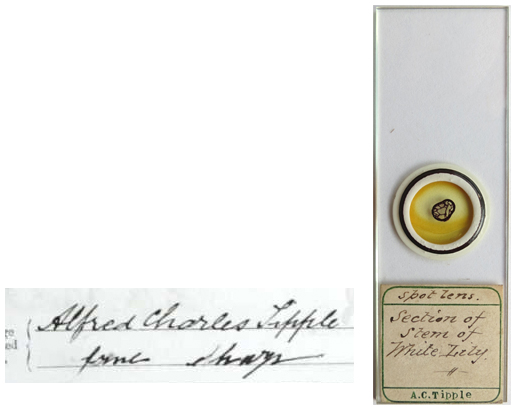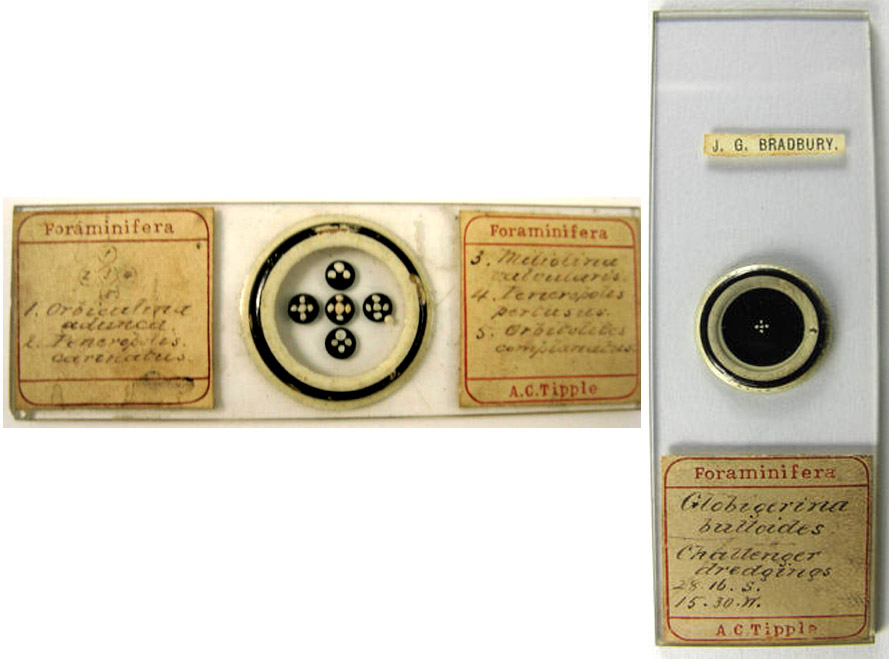Alfred Charles Tipple, 1850 - 1887
by Brian Stevenson
last updated February, 2013
An amateur
microscopist and slide maker, Alfred Tipple produced and traded microscope
slides for about 13 years, between ca. 1874 and his early death at the age of
36, in 1887. Tipple’s mounts of foraminifera were well regarded by his
colleagues in the Quekett Microscopical Club. As did many other Victorians,
Tipple appears to have a keen interest in parasitic insects and other
blood-sucking arthropods. He also exhibited a variety of other specimens to the
Club, and offered such in exchange to other microscope enthusiasts.

Figure 1.
Microscope slides prepared by A.C. Tipple. He
clearly used the same printer as did fellow Quekett Microscopical Club member
Henry E. Freeman, an example of whose slides is shown on the far right. The word “botanical” was undoubtedly added to the two leftmost slides by a later owner, as Tipple would have known that the sea urchin Cidaris is an animal.
Arthur
Charles Tipple was born November 17, 1850 in Clapham, Surrey, England, His
father, Charles, was a surgeon and apothecary (pharmacist/chemist). Within a
month or two after Alfred’s birth, the family moved to Baldock, Hertfordshire,
where Charles established a practice. Arthur’s parents died while they were
fairly young: his mother, Eleanor, passed away in 1870 at the age of 47, and
his father died in 1874 when 53.
Arthur
became a clerk, specializing in law. The 1871 census recorded the 20 year-old
as living with an uncle’s family in Hornsey, Middlesex (London area). The
uncle, Henry Marshall was then “clerk to
the Curates Augmentation Fund”, and held similar jobs through most of his
life. It is possible that Arthur learned some of the business of clerking from
his uncle. If so, one hopes he did not learn too much. Uncle Henry was
convicted of embezzlement in 1878, and spent 7 years in prison.
The first
record of Arthur Tipple’s interest in microscopy is an 1874 exchange
advertisement in Hardwicke’s
Science-Gossip (Figure 2). His offer of slides of “parasite of partridge” suggests that he was a bird hunter.

Figure 2.
Exchange advertisements from ‘Hardwicke’s
Science-Gossip’. These are all the known advertisements published by A.C.
Tipple. He evidently emphasized foraminifera, parasites and horns/hooves –
excellent polariscope objects. Coincidentally, Tipple’s sole 1884 exchange
offer was printed adjacent to one by his microscopy colleague, H.E. Freeman.
Alfred
married Jane Sharp on August 21, 1877. From his signature on their parish
marriage record, we see an example of Alfred’s normal handwriting (Figure 3).
The block handwriting on his microscope slide labels, with swooshes and other
affectations, was fairly common at the time. Similar letter formations are
frequently seen on slides produced by Henry Freeman, William Firth and many
other contemporary makers.

Figure 3.
To the left is Alfred Charles Tipple’s signature
from the parish record of his 1877 marriage. Tipple’s cursive is strikingly different
from the stylized block handwriting he used on slide labels, such as that shown
on the right and in Figure 1. The block printing would surely have been easier
for other microscopists to read.
The 1874
slide exchange offer (Figure 2) located Tipple at 16 Ennis Road, Finsbury Park,
London. He was still at that location when he married in 1877. By the time of
the 1881 census, Alfred, Jane and two toddler daughters lived at 1 Monsell
Villas, Monsell Road, in Islington. With them lived Jane’s widowed mother and
her elder brother, a driver with the Royal Artillery.
Alfred
Tipple joined the Quekett Microscopical Club on May 23, 1884. The following
week, at a special exhibition meeting, he displayed a slide of Lagena foraminifera. At about the same
time, Tipple published his second known exchange request, asking for “foraminiferous material, parasites, &c.”
and offering in exchange slides of “selected
and well mounted” foraminifera (Figure 2). On February 27, 1885, Tipple
donated six slides of foraminifera to the Quekett Club. These were apparently
exceptional preparations, as the Club minutes reported that “The Secretary having
called special attention to the very beautiful series of slides of Foraminifera
presented by Mr. Tipple .. special votes of thanks were passed, on the motion
of the President”. These were probably
similar to the arranged foraminifera slides shown in Figure 4.

Figure 4.
Two examples of Tipple’s well-regarded mounts of foraminifera.
Screen shots from internet auctions.
Tipple
exhibited additional slides to the Quekett throughout 1885. There was a
diversity of specimen types, including “Parasite
of Crane”, “Chelifer museorum” and
“Section, Ovary of Orchid”. That year also brought the third, and
last, known exchange request from Tipple (Figure 2). He again requested
foraminiferous material, but added sectioned animal horns and hoofs to his
repertoire of offerings. The slides shown in Figure 1 include a cross-section
of a Cidaris spine (although someone
noted “botanical” on the label, Cidaris is an animal, being a type of
sea urchin). Alfred Tipple clearly developed skills in making many disparate
types of slides, from precisely arranging tiny foraminifera to finely grinding
sea urchin spines to clearing, flattening and arranging arthropods.
His 1884
and 1885 advertisements, and those years’ membership roles of the Quekett
Microscopical Club gave Tipple’s address as 35 Alexander Road, Upper Holloway.
The 1886 Club roster gave the address 19 Stavordale Road, Highbury Hill. The
next year, the Tipples had moved again to 1 Chilton Terrace, St. Lawrence, Kent.
The reason for these frequent relocations is not known.
Alfred
Tipple died on August 15, 1887, when he was only 36 years old. Jane raised their children alone, and died in 1927.
Acknowledgments
My thanks to James and Suzanne McClintock for their generous
help in locating slides by Alfred Tipple, and for their aid in this and other
historical studies.
Resources
Bracegirdle, Brian (1998) Microscopical Mounts and Mounters, Quekett Microscopical Club, London, pages 94, 172 and 174, plates 34-E and 35-R.
England census, birth, marriage and death records, accessed through ancestry.co.uk.
Hardwicke’s Science-Gossip (1874) Exchange offer from A.C. Tipple, Vol. 9, page 240.
Hardwicke’s Science-Gossip (1884) Exchange offer from A.C. Tipple, Vol. 20, page 24.
Hardwicke’s Science-Gossip (1885) Exchange offer from A.C. Tipple, Vol. 1, page 24.
“Hilton Family Tree”, file on Alfred Charles Tipple, http://trees.ancestry.co.uk/tree/21768607/person/1465853008, accessed December, 2012.
Journal of the Quekett Microscopical Club (1884) Election of A.C. Tipple and description of an exhibited slide, Series 2, Vol. 2, pages 42 and 46.
Journal of the Quekett Microscopical Club (1885) Donations by A.C. Tipple and description of exhibited slides, Series 2, Vol. 2, pages 151, 154, 246 and 248.
Journal of the Quekett Microscopical Club (1885) Membership list, Series 2, Vol. 2.
Journal of the Quekett Microscopical Club (1886) Membership list, Series 2, Vol. 3.
Marriage record of Alfred Charles Tipple and Jane Sharp (1877) Parish records of St. Andrew Holborn Church, accessed through ancestry.co.uk.
Probate record of Alfred Charles Tipple (1877) accessed through ancestry.co.uk.



